by Winding Pathways | Aug 25, 2022 | (Sub)Urban Homesteading, Birds, Nature
While We Were Sleeping
We were tired on the evening of August 21. Crawling into bed at 9 pm we were oblivious to the traffic jam winging over our insulated roof. Late August. The fall bird migration has started. That night it picked up steam.
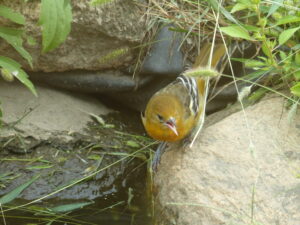
Birds stop for a drink and to fill up on the berries nearby.
In the morning we checked the BirdCast Migration Database and were astounded to learn that 883,000 birds crossed Linn County, Iowa, where we live, the evening before. Heading south, large numbers of birds began streaming overhead shortly after we turned off our reading lights. Migration usually starts just after sunset and peaks in the first couple of hours of darkness, but last night birds streamed over most of the night going south at an average speed of 26 miles an hour at an altitude of up to 2400 feet.
Technology Merged with Observation
How do we know? Well, we didn’t sit on the roof with night vision optics. We merely logged into the Cornell Laboratory of Ornithology’s Migration Dashboard at birdcast.info.
The technology is almost as fascinating as the information it reveals. The Live Migration videos show the action through the night. Fascinating!
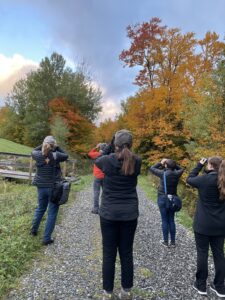
Pause to listen and look. Binoculars help.
The Lab collects data from 143 radar installations scattered across the country. This provides a clear picture of the number of birds migrating at any given time, their direction and speed, and how high they are flying. Radar can’t determine species, but years of data collected by ground observation and compiled by the Lab through eBird helps give an accurate picture of the likely species on the move. The list shows that probably 14 species went overhead while we slept.
Until a few years ago we were casual birders. The amazing science and sharing the Lab of Ornithology provides fascinate us and has sensitized us to the marvel and beauty of birds, their amazing navigation ability, their adaptations, and, unfortunately, the threats they face.
Apps Enhance Birding Experience
We have the Lab’s Merlin and Bird apps on our phone. The first is a pocket-sized field guide packed with more information than old paper field guides ever were able to provide. It helps us identify an unknown species, see its range, and even hear its calls and songs. A new feature helps identify birds by their song. Click it on and hold the phone toward where the call is coming from, and it identifies the species, usually correctly.
eBird enables us to easily compile a list of birds sighted on a particular day and forward our data to the Lab. Thousands of birders worldwide send their data, giving the Lab invaluable information on where birds are and how they move……as well as population trends.
Technology and Birds! What’s Not to Love?
Love technology? Love birds? These wonderful tools provided free from the Cornell University Laboratory of Ornithology merge the two. It’s a portal to many pages and other sites that include everything from nest webcams to detailed information about each species. Kudos to the Lab.
by Winding Pathways | Aug 11, 2022 | (Sub)Urban Homesteading, Bugs, Garden/Yard, Garden/Yard, Nature
Imagine how embarrassing it would be to be caught stark naked in public. Maybe that’s how the Walking Stick, a huge insect, felt that we spotted clinging to a shelf outside our house.
About 3000 species of Walking Sticks live worldwide. All love hiding. Their camouflage is almost perfect. No doubt the one we discovered would have been far more comfortable clinging nearly invisible on tree bark.
Although common and huge some species can be upwards of 20 inches long! They’re nearly impossible to spot as they lurk on twigs and bark. We likely walk right by many. They simply hide in plain sight. The name of their order is Phasmatodea, meaning apparition. It perfectly describes them.
The one we spotted must have been lost. Rather than comfortably blending into the woods our gangly stick-looking insect contrasted against our shelf as naked as a jaybird. We couldn’t miss spotting it.
Herbivorous Walking Sticks spend nights munching on leaves and rest during daylight. Females are usually bigger than males and usually just drop their eggs to the ground. Growth is slow, and the babies can take three to 12 months to mature. That’s glacial growth for an insect, but they can live for two years if not devoured by birds, small mammals, or predatory insects. Insecticides devastate them.
Walking Sticks don’t bite or sting and are one of the thousands of nature’s wonders to discover in an ecologically healthy yard. They’re downright fascinating and fun to share with children.
-
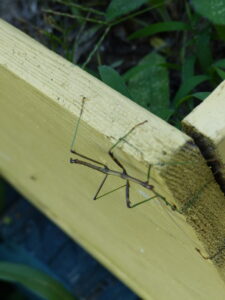
-
Easy to see
-
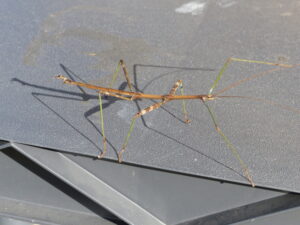
-
A large herbivore.
-
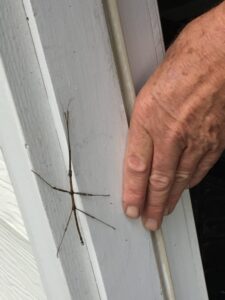
-
Walking Sticks are easy to spot on plain backgrounds.
by Winding Pathways | Jul 28, 2022 | (Sub)Urban Homesteading, Birds, Nature
Views From the Recliner
Guest Blogger, Susan Fellows
My first-floor, corner apartment sits on the edge of a large green space and parking lot surrounded by a stand of pines, maples, and oaks. On one side is a complex of boutique stores, restaurants, and apartments/condos. Nearby and opposite the greenspace is a residents’ home for memory care. Last year I had placed outside my living room window a double shepherd’s crook feeder visible from my recliner. I am older and have some medical issues that restrict movement. So, a good view of the outside and the birds is important to me. They are entertaining! That first year I had what seemed like a million new sparrows that went through the wild bird seed like crazy. This year, I haven’t seen as many newly fledged sparrows.
Attracting a Variety of Birds
This year I put out several feeders on the double shepherd’s crook – one for black oil sunflowers and another for wild bird seed. Also on that post, I have a “cage” of suet and a sock of blick niger thistle seed. A couple of months ago I added a single shepherd’s crook with a mealy worm feeder. This spring and early summer I have seen pairs of the house and purple finches, house and chipping sparrows, several pairs of goldfinches, and at least one pair of bluebirds. They come to the sunflower and thistle seed, which the goldfinches seem to prefer. About a week ago, a mockingbird started coming and feeds entirely on the suet. Recently I put out wild bird food which hangs from the other hook on the double shepherd’s crook. I had put out mealy worms that I prefer the bluebirds have, but the house and chipping sparrows decided they own it. Flying over and calling from the grassy area are killdeer. With their shrill call, they are easy to spot as they hobble away with their fake broken wing act to lure predators from their ground nest. They nest in low vegetation, like the nearby grassy lawn.
-
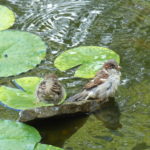
-
A water source helps attract birds.
-
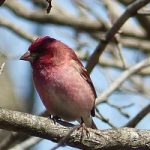
-
Some birds homestead at Winding Pathways.
-
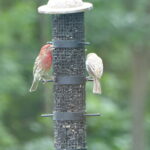
-
The house finches eat serenely.
Fledging Bluebird
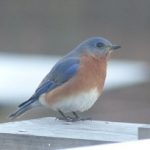
Male Bluebird
The memory home nearby has a bluebird nesting box on the quiet side of the building. I believe that is where the bluebirds come from.to feed. Several days ago I heard quite a racket from the feeding station. Looking outside, I spotted a fairly large bird with a highly streaked white breast, perched on the top of the single shepherd’s crook. An adult bluebird was also on the feeder. The bird making the racket had its beak open waiting for the adult to feed it. It didn’t. It was time for the baby to learn to eat on its own. At that point, I could see bright blue in its tail feathers. I was so excited! It was a baby bluebird!
Another day, I was looking out my window when suddenly a little, male chipping sparrow with his chestnut top on his head arrived bringing with him a smaller bird that landed close to him, beak open. Dad bird fed baby bird several pieces of seed and then showed baby bird how to do it, but as I watched baby still hadn’t got the hang of it.
Invasion by New Comers to the Feeder
A newcomer at the mealy worm feeder appeared recently – starlings. I was invaded by baby starlings. At least 15 had taken over the feeders. To lure them away from the hanging feeders, I put out a seed block on the ground at the base of the other feeders. Although I can’t see it, I expect the starlings may be happier at it than just eating crumbs from the open mealy worm feeder. I hope they will leave soon. They eat everything.
I have enjoyed sharing all these spring bird-related events with Winding Pathways. I expect to be inundated with newly fledged sparrows any time soon. Enjoy your birding adventures as I have enjoyed what I can see from my recliner.
by Marion Patterson | Jul 21, 2022 | (Sub)Urban Homesteading, Nature
Nearly everyone remembers a brief, often scary time. Usually, it comes within months of high school graduation. It’s time to leave the familiarity of home and venture out on new endeavors. Change is often exciting but it requires venturing out into the unknown – often alone.
Rich remembers moving from New Jersey to a state he’d never been to, Idaho, to start college. Within days he was sworn into the Army as a student soldier. Lots of change.
Marion ventured forth in the same year but not quite so far. Her launching took her to Plymouth State University a ways north of her home.
Wildlife babies face many of the same huge life changes and uncertainties that we did, but they do it at a much younger age. When we walk along early summer trails, we often see baby cottontail bunnies. Some are no bigger than our hands, but they are on their own in a world full of bunny hazards. They must learn how to find food, water, and shelter while all sorts of predators try to make them food.
In June we watched several broods of house wrens fledge from boxes we put up near our kitchen window and in the garden. Earlier we’d seen mom and dad bring in sticks to make a nest. Then we didn’t see them often for a couple of weeks as they incubated their tiny reddish eggs.
-
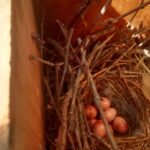
-
Wrens lay several small, reddish eggs.
-
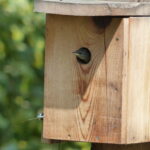
-
Wrens peek out of the box.
-
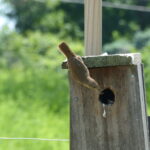
-
Wren adults are busy feeding the young.
On a miraculous day, those eggs become hungry but helpless babies. Mom and dad worked endlessly catching and delivering juicy caterpillars and adult insects to feed the youngsters a high-protein diet. They grow quickly, and a couple of weeks after hatching we see beaks poking out the birdhouse entrance.
It must be scary venturing forth, but mom and dad encourage them to fledge. Out they go. But life is not easy. They need to learn how to fly, where to find food, and how to be safe. Parents help for a while but soon they are on their own while mom and dad make a new nest and raise a second brood.
Launching…. fledging……is a tough transition time for people, bunnies, birds, and just about any other young animal.
by Winding Pathways | Jul 14, 2022 | Garden/Yard, Garden/Yard
Gardeners across the world proudly bring freshly picked vegetables and fruits into the kitchen. They’re lucky to have an amazing array of delicious plants to grow and enjoy. It wasn’t always that way.
Consider Native Americans. Prior to Columbus, many lived in cities and big towns surrounded by gardens and farm fields. They grew corn, beans, and a diversity of squash and pumpkins, but they knew nothing of many of today’s common vegetables. Residents of Asia, Africa, Europe, and Australia back then also farmed and gardened, but their crop choices were limited.
-

-
Many foods were cultivated by indigenous people.
-

-
Cahokia Mound
New World & Old World
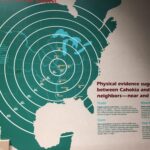
Indigenous contacts ranged far and wide.
It changed quickly following what’s called the Great Columbian Exchange. Shortly after Columbus set foot on Hispaniola people began deliberately and purposefully moving plants and animals around the world. Many were valuable and diversified the food chain on all continents. Others quickly became pests………most weeds infesting American gardens originated in the Old World.
Imagine Southern Italian cuisine without tomatoes! This delicious vegetable originated in South America and was unknown in Italy before the Columbian Exchange. Same with potatoes. The Irish potato originated in South America.
It went both ways. Today’s gardeners enjoy vegetables originating all over the globe. Here’s a brief list of where common foods came from:
NATIVE OF THE NEW WORLD
Pumpkins and squash, Beans except for fava, Corn, Potato, Sweet Potato, Tomato, Pepper, Jicama
-
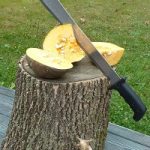
-
A machete is useful in cutting squash.
-
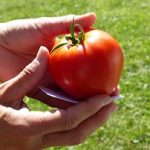
-
The sweetness of summer’s bounty.
-
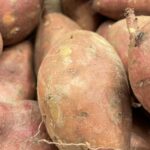
-
Sweet potatoes are a healthy vegetable.
NATIVE OF EUROPE, ASIA, and AFRICA
Watermelons and cantaloupes, Onions, leeks, and garlic, Turnips, Carrots and parsnips, Yams, Radish, Celery, Asparagus, Beets, and Chard, are the same species, Cabbage, Cauliflower, Brussel Sprouts, Broccoli – all related, Endive, Lettuce, Rhubarb, Spinach, Okra, Cucumber, Peas.
The Columbian exchange also included grains and fruit. Corn is American but wheat, barley, rye, and oats are from the Old World. Apples, peaches, pears, and cherries (except for the bitter American black cherry) are also Old World. Brambles and strawberries apparently lived in both the Old and New Worlds prior to Columbus. Grapes eaten fresh and used for juice and wine came from the Old World but several species also are native to the Americas.
-
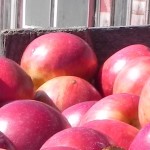
-
A favorite fall harvest is apples.
-
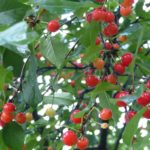
-
Tart cherries come ripe in June.
Thanks to the movement of useful plants gardeners worldwide enjoy a diversity of plants to grow and eat.
by Winding Pathways | Jul 7, 2022 | (Sub)Urban Homesteading, Chickens, Garden/Yard, Nature, Weeds
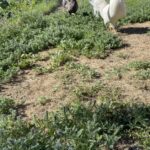
Chickens in run
A chicken run is one tough place for plants to live, and our run at Winding Pathways is even tougher than most.
Every day we let our chickens roam around the run. A bright baking sun broils the sandy soil all day long, so it’s hard to imagine that any plant can thrive there. And, chicken run plants face another challenge. The birds love greenery and usually devour every plant they find. As a result, most chicken runs are just bare dirt that’s either dusty or muddy.
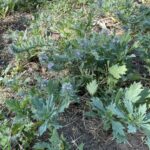
Flower and leaf
Big Bracht Verbena (Verbena bracteata), sometimes called Prostrate Vervain, is up to the challenge. It carpets our chicken run. We didn’t plant it. Verbena moved in on its own. Hopefully, our chickens enjoy viewing the plants’ tiny soft blue flowers.
Big Bracht Verbena is common across much of North America, but it’s easy to overlook. Rarely causing problems, it lives in the most difficult environments. The plant thrives in hot dry gravel soil along roads, in vacant lots, and in sidewalk cracks.
We like having this humble plant in our chicken run. It covers the soil, eliminating mud that follows rain. Chickens absolutely won’t eat it, but they love snatching the insects lured to the plant. It needs no human care, but we sometimes mow it if it gets a big shaggy by late summer.
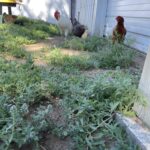
Foraging among verbena
One of nature’s mysteries is how plants have adapted to thrive in all sorts of environments, even harsh ones. Hats off to Big Bracht Verbena.























